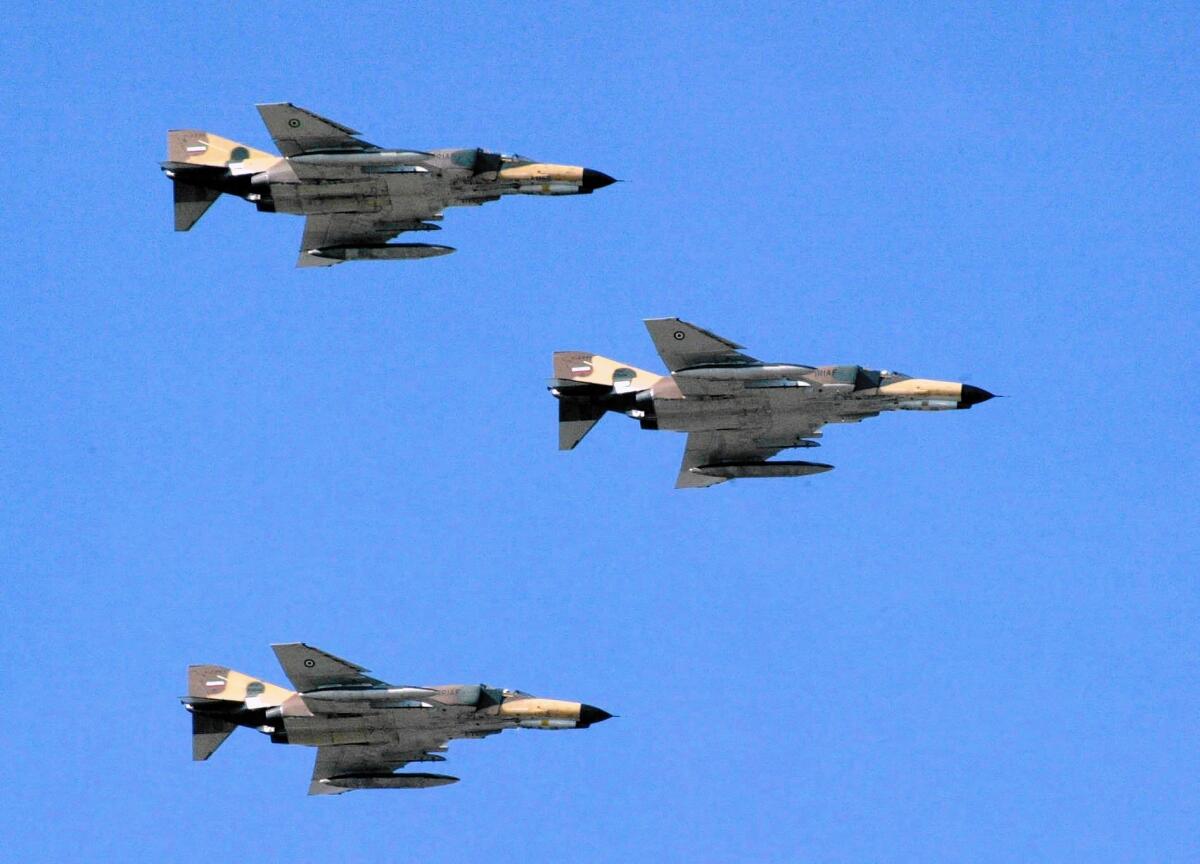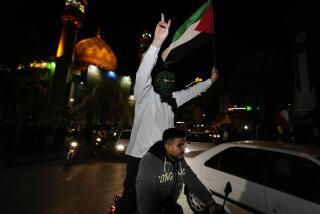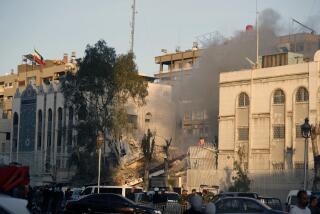Recent Iran airstrikes in Iraq help drive Islamic State from 2 towns

Iranian warplanes have launched several airstrikes in recent days against Islamic State militants in eastern Iraq, U.S. and Iranian officials said Tuesday, the latest sign that America’s longtime adversary is conducting a parallel but largely unacknowledged military campaign in the conflict.
At least some of the bombing runs were by F-4 Phantom jets, American-built warplanes provided to Tehran before the 1979 Islamic Revolution that ousted Mohammed Reza Pahlavi, a close U.S. ally.
In the shifting political landscape of the latest Iraq war, Tehran and Washington are in effect aligned on the same side and are conducting dual but separate military operations to back the beleaguered Baghdad government.
The U.S. and Iran have sent trainers and advisors to assist pro-government forces struggling against the Sunni Muslim fighters who swept into Iraq from Syria during the spring and summer. Iran’s use of airstrikes marks an escalation of its role.
But U.S. and Iranian officials have repeatedly disavowed any direct coordination on military operations and have said little in public about the recent airstrikes.
Four Iranian jets attacked Islamic State positions during an offensive in Iraq last month to retake two towns, Saadiya and Jalawla, less than 20 miles from the Iranian border in the eastern province of Diyala, said Hamid Reza Taraghi, a conservative Iranian politician who is well informed on military matters.
“Iran regards the area as a buffer zone and does not tolerate any military threats within that buffer zone,” Taraghi said in an interview in Tehran. He said Iraqi officials “asked us to be quiet about it.”
Iraqi officials also have remained publicly silent about the airstrikes, although Baghdad approved the operation and ensured that the airspace was free of American or other coalition warplanes, said two U.S. military officials who declined to be identified, citing the sensitivity of the matter.
There have been “a few” recent Iranian airstrikes, one of the officials said.
“We are not coordinating with the Iranians,” the official added. “Iraq owns the airspace.”
Al Jazeera aired video this week that appeared to show an Iranian F-4 on a bombing run as recently as Sunday.
The F-4 Phantom is a twin-engine, fighter-bomber jet built by McDonnell Aircraft Corp. for the U.S. Navy from 1961 until production ceased in 1981. Although the jets were sold around the world, only Iran and Turkey are said to still fly them and only a dozen or so are believed to be in operating condition.
Some Iraqi officials privately complain that the Obama administration has imposed limits on its own air campaign, saying that in an effort to prevent civilian casualties, U.S. airstrikes have avoided hitting Islamic State fighters in towns and villages. That has slowed the campaign to retake territory held by the militants, they say.
“The U.S. is always our first choice” for military assistance, but “if we need to seek help elsewhere, we will,” said one Iraqi official, who asked to remain anonymous in discussing his government’s thinking.
The reluctance on all sides to publicly acknowledge the Iranian airstrikes stem from sectarian and diplomatic sensitivities. But as the conflict widens, the complexities are becoming harder to manage.
Although Iran’s air force is aging and small by Western standards, the airstrikes are a signal of Tehran’s determination to back the Shiite Muslim-dominated government in Baghdad against the Sunni fighters who have captured much of western and central Iraq.
But too visible a military role by the Shiite-led government in Tehran could deepen concerns among Iraq’s minority Sunni population and America’s regional Sunni allies, such as Saudi Arabia, United Arab Emirates and Qatar, that war against Islamic State is evolving into a sectarian clash that will further strengthen Iran and its proxies.
Islamic State has won sympathy from many Sunni Iraqis who accuse the Baghdad government of marginalizing the country’s Sunni minority and taking orders from Tehran. Iranian officials are also concerned about the possibility that Islamic State or other militant groups will begin recruiting from Iran’s Sunni minority.
For the Obama administration, the growing Iranian role is likely to prompt criticism from Republicans that U.S. assistance to Iraq has been too limited since the 2011 pullout of U.S. forces and has given Iran an opening to deepen its military ties with Iraqi Prime Minister Haider Abadi and his government.
For Abadi, the decision to allow Iranian airstrikes highlights the far-reaching changes in Iraq’s politics since the 2003 ouster of Saddam Hussein, the dictator who ordered an invasion of Iran in 1980. The eight-year war, which featured vicious World War I-style trench warfare and poison gas attacks, left more than 1 million soldiers and civilians dead, and many more wounded.
But Iran played an increasing role in Iraq during the civil war that followed the U.S.-led invasion in 2003 and provided strong support to Abadi’s predecessor, Nouri Maliki, during his eight years as prime minister.
In recent months, Iranian officials grew alarmed at the Sunni militants’ advance to areas close to Iran’s long border in ethnically and religiously mixed Diyala province.
As a result, Iranian jets helped Iraqi and allied forces, including Kurdish fighters and Shiite militiamen, chase Islamic State fighters from the two towns in Diyala in late November.
Kurdish commanders have acknowledged receiving weapons and other aid from Iran in the battle to take back the two towns. Kurdish officials said there were no U.S. airstrikes during the offensive.
Fighting alongside Iraqi army units was the Badr Organization, a powerful Shiite militia in Iraq that is backed by Iran. The militia’s chief, Hadi Amiri, who is also transportation minister in the current Baghdad government, led the militiamen into battle, the Badr Organization said.
At a Pentagon news conference Tuesday, Rear Adm. John Kirby, a spokesman, declined to confirm the Iranian air attacks. “We are not taking a position on these particular reports regarding these particular strikes,” he said.
Iran’s semiofficial Fars News service quoted Gen. Masoud Jazayeri, deputy chief of staff of Iran’s armed forces, as denying cooperation with U.S. officials.
“The Islamic Republic of Iran believes that the United States is the cause of the unrest and problems in Iraq and is the reason for the terrorist operations of Daesh,” the general said, repeating Tehran’s official line and using an Arabic acronym for Islamic State.
The number of Iranian air attacks is still tiny compared with the U.S.-led bombing campaign. Coalition aircraft have carried out 630 airstrikes in Iraq since Aug. 8 and 501 in Syria since Sept. 23, although many more flights return to base without using their ordnance.
The Iranian escalation comes as the Obama administration is in talks with Turkey about expanding U.S. airstrikes in northern Syria to create a protected area for Syrian rebels battling Islamic State.
Turkey is pressing the White House to use military force to oust Syrian President Bashar Assad in that country’s civil war. But the U.S. has held off so far, partly out of concern that using force against Assad would anger Iran, one of Assad’s closest backers.
Some critics contend that the Obama administration is too accommodating of Tehran, partly because the White House is pursuing high-level negotiations to halt Iran’s nuclear program, a priority for Obama.
Kimberly Kagan, president of the Institute for the Study of War in Washington, said Iran has slowly increased its presence in Iraq since June by sending in troops and its elite Quds Force.
“Iran aims not only to contain the Islamic State, but also to ensure that there is a Shia government in Baghdad that pursues Tehran’s regional interests, such as maintaining the Assad regime in Syria,” she said. “The United States should not rely on Iran, as a state sponsor of terrorism, to counter the terrorist threat from the Islamic State.”
Times staff writers Cloud and Hennigan reported from Washington and special correspondent Mostaghim from Tehran. Staff writer Patrick J. McDonnell in Beirut contributed to this report.
More to Read
Start your day right
Sign up for Essential California for news, features and recommendations from the L.A. Times and beyond in your inbox six days a week.
You may occasionally receive promotional content from the Los Angeles Times.








